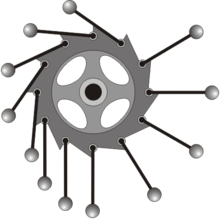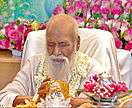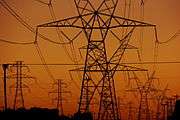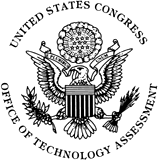Voodoo Science

The Road from Foolishness to Fraud
Voodoo Science: The Road from Foolishness to Fraud[1] is a book published in 2000 by physics professor Robert L. Park, critical of research that falls short of adhering to the scientific method. Other authors have used the term "voodoo science",[2][3] but it remains most closely associated with Park.[4] The book is critical of, among other things, homeopathy, cold fusion and the International Space Station.[5]
Categories
Park uses the term voodoo science (see the quote section below, Page 10) as covering four categories which evolve from self-delusion to fraud:
- pathological science, wherein genuine scientists deceive themselves
- junk science, speculative theorizing which bamboozles rather than enlightens
- pseudoscience proper, work falsely claiming to have a scientific basis, which may be dependent on supernatural explanations
- fraudulent science, exploiting bad science for the purposes of fraud
Park criticizes junk science as the creature of "scientists, many of whom have impressive credentials, who craft arguments deliberately intended to deceive or confuse."[6]
Examples cited

- Perpetual motion, free energy suppression and fringe physics claims
- Robert Fludd
- Garabed T. K. Giragossian
- The Energy Machine of Joseph Newman
- Better World Technologies (Dennis Lee)[7]
- Blacklight Power, formerly HydroCatalysis (Randell Mills)
- Cold fusion (Stanley Pons and Martin Fleischmann)
- Patterson Power Cell (James Patterson)
- Gravitational shielding (Eugene Podkletnov)



- Human spaceflight (in terms of actual importance to science since the rise of robotic spacecraft)
- International Space Station (for claims of necessity to conduct scientific research)
- Gerard K. O'Neill, L5 Society and space colonization
- Robert Zubrin, Mars Society, Biosphere 2 and a manned mission to Mars
- Voodoo science protected by government secrecy
- Project Mogul and the Roswell UFO incident resulting in a loss of public trust, as well as the later alien autopsy video hoax
- Edward Teller and Lowell Wood's work on the Strategic Defense Initiative (especially regarding the X-ray laser, but also "Brilliant Pebbles")
- Great Oil Sniffer Hoax
- Superstitions and pseudoscience
- Mars effect (astrology) claimed by Michel Gauquelin
- Parapsychology (e.g. Robert G. Jahn and Dean Radin)
- Placebos and alternative medicine
- Vitamin O
- Homeopathy
- water memory (proposed by Jacques Benveniste)
- Animal magnetism
- Magnet therapy
- Therapeutic touch (debunked by Emily Rosa at age nine)


- Other health claims
- Maharishi Effect (using Transcendental Meditation (TM) to effect a decrease in societal violence; the spike in murders during the 1993 Washington D.C. study is specifically mentioned)
- Deepak Chopra (who makes claims linking Ayurveda (traditional medicine native to India) with quantum mechanics)
- Electromagnetic radiation and health (especially related to power lines and cancer risk)
- "Paul Brodeur and Microwave News in particular, had given the public a seriously distorted view of the scientific facts." (Page 158)


- Contributing factors
- Mainstream media reporting voodoo science uncritically as infotainment
- Abolition of the Office of Technology Assessment
- Establishment of the National Center for Complementary and Alternative Medicine
Park also discusses the Daubert standard for excluding junk science from litigation.
Quotes
- I came to realize that many people choose scientific beliefs the same way they choose to be Methodists, or Democrats, or Chicago Cubs fans. They judge science by how well it agrees with the way they want the world to be. (Pages VIII-IX)
- [P]ractitioners [of pseudoscience] may believe it to be science, just as witches and faith healers may truly believe they can call forth supernatural powers. What may begin as an honest error, however, has a way of evolving through almost imperceptible steps from self-delusion to fraud. The line between foolishness and fraud is thin. Because it is not always easy to tell when that line is crossed, I use the term voodoo science to cover them all: pathological science, junk science, pseudoscience and fraudulent science. This book is meant to help the reader to recognize voodoo science and to understand the forces that seem to conspire to keep it alive. (Page 10)
- The integrity of science is anchored in the willingness of scientists to test their ideas and results in direct confrontation with their scientific peers. (Page 16)
- America's astronauts have been left stranded in low-Earth orbit, like passengers waiting beside an abandoned stretch of track for a train that will never come, bypassed by the advance of science. (Page 91)
- Few scientists or inventors set out to commit fraud. In the beginning, most believe they have made a great discovery. But what happens when they finally realize that things are not behaving as they believed? (Page 104)
- [T]he uniquely American myth of the self-educated genius fighting against a pompous, close-minded establishment. (Page 112)
- They are betting against the laws of thermodynamics. No one has ever won that wager. (Page 138)
Warning signs
Drawing on examples used in Voodoo Science, Park outlined seven warning signs that a claim may be pseudoscientific in a 2003 article for The Chronicle of Higher Education:[8]
- Discoverers make their claims directly to the popular media, rather than to fellow scientists.
- Discoverers claim that a conspiracy has tried to suppress the discovery.
- The claimed effect appears so weak that observers can hardly distinguish it from noise. No amount of further work increases the signal.
- Anecdotal evidence is used to back up the claim.
- True believers cite ancient traditions in support of the new claim.
- The discoverer or discoverers work in isolation from the mainstream scientific community.
- The discovery, if true, would require a change in the understanding of the fundamental laws of nature.
Reception
Matt Nisbet in the Skeptical Inquirer noted that the reaction to Voodoo Science has been mostly favorable.[9]
Bob Goldstein in a book review for Nature Cell Biology described Park as an equivalent to Richard Dawkins and Stephen Jay Gould, scientific writers who have "talent for defending a view of the world that is perfectly rational and free of witchcraft and superstition."[10]
American chemist Nicholas Turro wrote "the book is entertaining and provocative reading... Whether or not you agree with Park's take on voodoo science, a message of the book is that if scientists do not take a more significant role in the way that science is disseminated to the public and especially to politicians, voodoo science will continue to survive."[11]
The mathematician Malcolm Sherman in the American Scientist gave the book a positive review stating "Park does more than analyze and expose various kinds of bad ("voodoo") science. He demonstrates how valid science is distorted or ignored by the media and by those (including scientists) seeking to influence public policy."[12] The physicist Kenneth R. Foster also positively reviewed the book concluding "Park is an articulate and skeptical voice of reason about science."[13]
Reviewing the book for The New York Times, Ed Regis compared it positively to the 1957 book by Martin Gardner, Fads and Fallacies in the Name of Science, calling Voodoo Science a "worthy successor" and praising it for explaining why various purportedly scientific claims were in fact impossible.[5] Science writer Kendrick Frazier wrote "Robert Park has brought us a book that has a freshness and originality—and an importance and potential for influence—perhaps not seen since Gardner’s first."[14]
Robin McKie for The Observer described it as "an admirable analysis: wittily written, vivid and put together without a hint of malice."[15]
Rachel Hay in a review wrote that Park had "debunked expertly" pseudoscience topics such as homeopathy, cold fusion and perpetual motion machines but the book is not easily accessible to students.[16] However, S. Elizabeth Bird an anthropology professor recommended it for "students who need to establish a grasp of the scientific method."[17]
Bruce Lewenstein wrote a critical review claiming Park had lumped together pathological science, junk science, pseudoscience and fraud all together as voodoo science but this is problematic as "each category alone is fraught with definitional, historical, and analytical difficulties."[18] Brian Josephson wrote that the book, while giving "the official story regarding a number of 'mistaken beliefs' ", did not provide "the additional information that might lead one to conclude that the official view does not tell the whole story."[19]
See also
- Antiscience
- Cargo cult science
- Denialism
- Politicization of science
- Scientific misconduct
- Scientific skepticism
- List of cognitive biases
- List of experimental errors and frauds in physics
- List of topics characterized as pseudoscience
- Quackery
Specific topics
- 1023 Campaign
- Energy Catalyzer
- Flim-Flam!
- Franz Tausend
- Frye standard
- Hafnium controversy
- Heinz Kurschildgen
- John Ernst Worrell Keely
- MMR vaccine controversy
- Piltdown Man
- Séralini affair
- Steorn
References
- ↑ Park, Robert L (2000), Voodoo Science: The road from foolishness to fraud, Oxford, U.K. & New York: Oxford University Press, ISBN 0-19-860443-2, retrieved 14 November 2010
- ↑ Oversight Hearing on the Office of Juvenile Justice and Delinquency. Committee on Education and Labor. Subcommittee on Human Resources. United States Congress. 1984. Retrieved 16 October 2011.
- ↑ William Booth. (1988). Voodoo Science. Science. New Series. Vol. 240, No. 4850. pp. 274-277.
- ↑ "Voodoo Science". The Skeptic's Dictionary.
- 1 2 Ed Regis. (2000)."Theres One Born Every Minute". The New York Times.
- ↑ Robert L. Park. (2000). p. 171
- ↑ Michael Maiello (6 June 2005). "Power Failure" at the Wayback Machine (archived May 3, 2007). Forbes.
- ↑ Robert L. Park. (2003). "Seven Warning Signs of Bogus Science". The Chronicle of Higher Education.
- ↑ Matt Nisbet. (2001). "A Look Back at the Best Skeptic Book of 2000". Csicop.org. Retrieved 2014-07-12.
- ↑ Bob Goldstein. (2000). The Professional Debunker (review of the book Voodoo Science: the Road from Foolishness to Fraud, by Robert L. Park). Nature Cell Biology. Vol 2. p. 212.
- ↑ Nicholas Turro. (2002). Book Review: Voodoo Science. The Road from Foolishness to Fraud. Edited by Robert L. Park. Angewandte Chemie. Vol. 41, Issue 14. p. 2436.
- ↑ Malcolm J. Sherman. (2000). "Exposing Fools Gladly". American Scientist. Vol. 88, No. 5. pp. 461-462.
- ↑ Kenneth R. Foster. (2000). Unreal Science. Science. New Series, Vol. 288, No. 5471. p. 1595.
- ↑ Kendrick Frazier. (2000). Voodoo Science: The Road from Foolishness to Fraud. Physics Today. Vol 53, No. 10. pp. 78-80.
- ↑ Robin McKie. (2002). "Paperback of the Week". The Observer.
- ↑ Rachel Hays. (2001). Voodoo Science: The Road from Foolishness to Fraud by Robert L. Park. The American Biology Teacher. Vol. 63, No. 2. p. 140
- ↑ S. Elizabeth Bird. (2002). Voodoo Science: The Road from Foolishness to Fraud by Robert L. Park. Human Biology. Vol. 74, No. 4. pp. 621-623.
- ↑ Bruce V. Lewenstein. (2004). Voodoo Science: The Road from Foolishness to Fraud. Isis. Vol. 95, No. 2. p. 341,
- ↑ Josephson, Brian. "Grey areas on the blacklist". Times Higher Education Supplement. Retrieved 18 August 2014.
